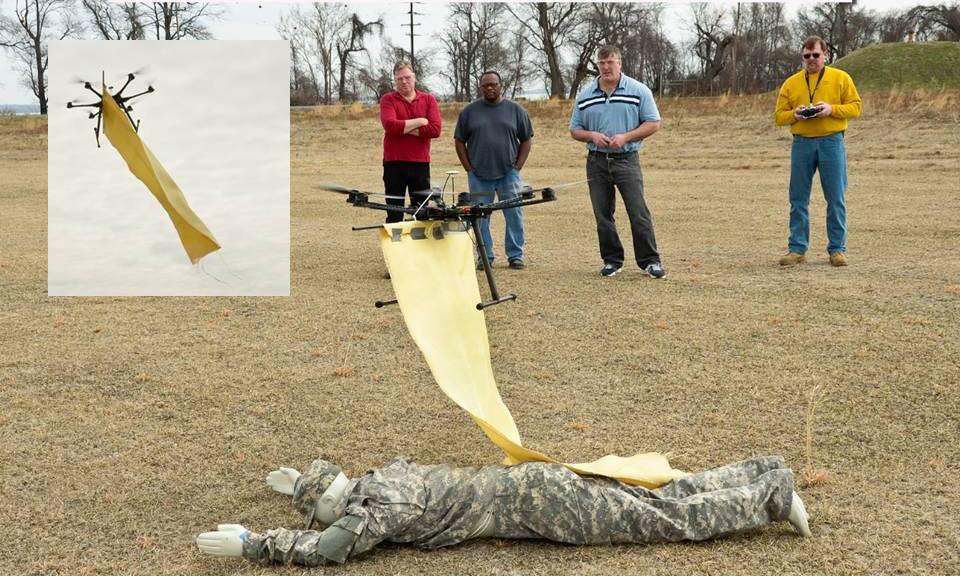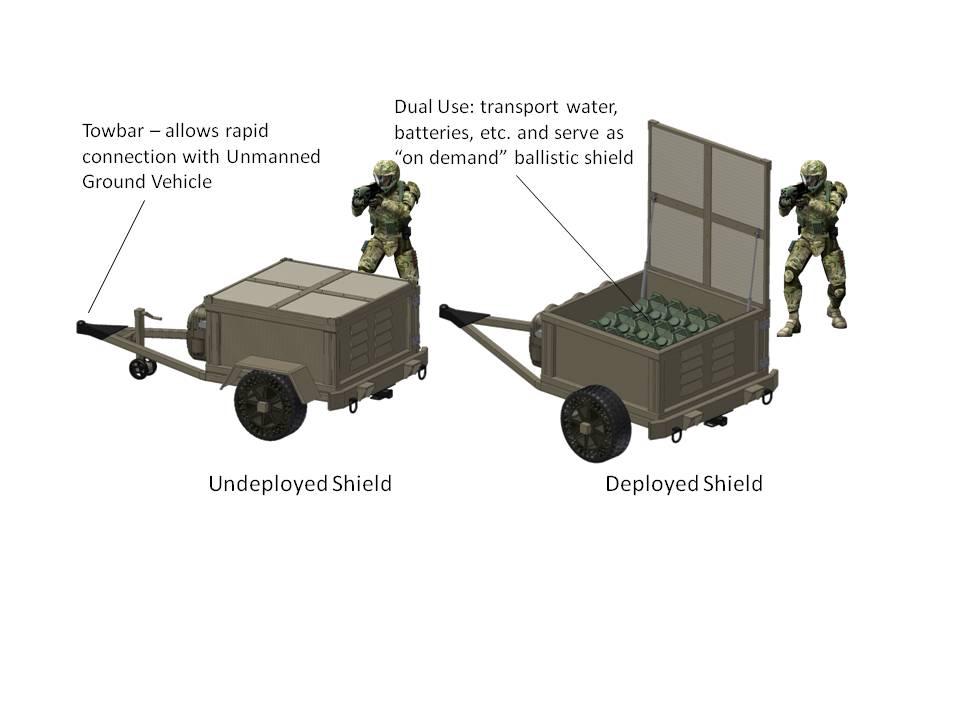Building an Autonomous Army of Protection
How do you stop a rifle round shot at a soldier’s head? Researchers from the U.S. Army and the Massachusetts Institute of Technology are in the nascent stages of developing technologies to field unmanned assets that might do just that.
The U.S. military for decades has employed unmanned systems—from dropping bombs miles above the Earth’s surface to detecting underwater mines from miles below. Now, researchers and scientists are on the threshold of tweaking the technology as part of a new concept for the use of unmanned assets, which could bring an army of autonomous protective robots to the battlefield.
“We’re starting to think about armor and protection in a fundamentally different way,” says Michael S. Strano, the Carbon P. Dubbs professor of chemical engineering at the Massachusetts Institute of Technology (MIT). “Instead of thinking about personal protection as being attached to an individual or even a vehicle, it’s about reducing the effectiveness of projectiles in geographical areas. Broadly speaking, it’s how to use technologies in the environment to reduce the effectiveness of everything from small arms fire to projectiles in general.”
An Army research project called Robotic Augmented Soldier Protection (RASP) is an unprecedented effort to use unmanned assets solely to protect or replenish troops in hostile situations. “What we’re trying to do here is something really quite disruptively different—and that’s something that we’ve never been able to even consider until recently,” says Shawn Walsh, a researcher leading the Agile Manufacturing Technology team for the U.S. Army Research Laboratory (ARL) at Aberdeen Proving Ground in Maryland.
People tend to associate unmanned systems with drones, he says, particularly drones that deliver lethal payloads. And people tend to think of improved soldier protection as more body armor. “One of our core missions is finding better ways to protect the soldier, and more recently, that’s come to also include what’s called unburdening the soldier,” Walsh declares. “Unburdening the soldier simply means a recognition of the fact that, even though we might have good intentions by putting more and more armor on them, at some point, we’re going to potentially overburden them so they can’t move as fast or perform their functions as easily.”
Throughout the history of war, an advance in weaponry has netted a corresponding advance in armor. “We’re at a point in history now … where offensive weaponry is on one side of the seesaw, and it’s never been easier for someone to launch projectiles that are very difficult to stop,” says Strano, a member of the Institute for Defense Analyses’ Defense Science Study Group, supported by the Defense Advanced Research Projects Agency (DARPA). He also is part of ARL’s Open Campus program, an approach aimed at ensuring a continuous flow of people and ideas toward transformative scientific discovery, innovation and transition critical to national security. Open Campus is not a funding stream for collaborators, but instead opens a premier military research facility to engage academia, other government agencies, industry and nontraditional innovators to work on solutions to uniquely military problems.
“What is new are the dramatic advances in technologies, such as wireless communications, computer control, actuators, sensors and autonomous systems design that now allow disruptive unprecedented capability that has never been possible before,” Walsh suggests. ARL researchers, in collaboration with scientists from MIT, the U.S. Army Research, Development and Engineering Command (RDECOM) and industry partners, have focused efforts on the opposite end of the unmanned spectrum: “How can we use unmanned systems to protect soldiers and noncombatant civilians in the face of hostile threats?” Walsh asks.
By August, the ARL could have an unmanned protective technology demonstrator to put into soldiers’ hands for evaluation. “One of our first-generation systems is going to be something that basically looks like a trailer that connects to the back of a small [unmanned vehicle] that can be towed around,” Walsh offers. “I know everyone is going to be expecting something out of Transformers or something. What they’re going to see … might look very ordinary. You wouldn’t even know it’s an unmanned system.
“Why is that important? Well, our focus is it isn’t necessary to put the most dazzling, aesthetically appealing technology in the field. Our focus is to put the most effective technology in the field, and sometimes we don’t even want people to know we’re putting stuff in the field,” he declares.
Imagine an unmanned system that could deliver to a wounded soldier a ballistic blanket for protection in an active hostile environment—a blanket equipped with sensors to monitor the soldier’s condition, for example, or containing blood-clotting and antibacterial agents for initial first-aid care, offers Walsh, a 29-year ARL veteran. Additionally, another unmanned ground system could provide ballistic protection and equipment for a combat medic to treat the soldier. “This trailer will be no ordinary trailer,” Walsh explains. “It will be a trailer that can be deposited by an unmanned system, a ground vehicle like an unmanned [all-terrain vehicle], which is already commercially available. It can carry water. It can carry batteries. It can carry rations. It can carry candy for civilians in certain areas. But if a conflict arises, it can transform into a ballistic shield that has dramatically higher levels of protection than we’ve been able to give them before because it will be near them.”
In addition to the unmanned systems, Walsh and other researchers are developing revolutionary materials that offer better protection for battlefield troops, such as ballistic composites that are very lightweight but remarkably good at stopping bullets and other projectiles. “Instead of thinking about 100 percent protection … there is much to be gained by making something less effective,” Strano says. “If you can reduce effectiveness, you can really open up possibilities. ... If you take the protective system off of a person and you suspend it in midair, or you put it as part of the environment that’s going to be deployed—like an airbag or be on a UAV or something like that—there are possibilities to think about, protection in new ways.”
Part of the RASP effort by the ARL’s Vehicle Technology Directorate (VTD) includes plans to use unmanned vehicles to demonstrate various mission capabilities. The plan, in part, is to leverage enhanced, optionally manned, robotic platforms developed under previous Army/Joint programs, says Elias Rigas, chief of the Vehicle Applied Research Division at ARL. They are tweaking the Polaris all-terrain vehicle to military grade, equipping the ATVs with numerous sensing and control capabilities to enable unmanned operations. Technologies currently on the platform include color cameras, Light Detection and Ranging (LIDAR) sensing methods, scanning lasers, Global Positioning System (GPS) navigation and infrared imagers, among others.
“We don’t have all of the answers,” Walsh adds. “That’s the exciting part of this. Unmanned systems offer opportunities that have not been exploited. For example, they can be disposable. They have their own power systems onboard. They can carry more payload than a human being. This has implications for developing totally new materials that we haven’t even conceived of.”
He likens the morphing of unmanned systems to the emergence of materials that sprung up because of the automobile industry, such as steel, rubber and glass. “In our case, unmanned systems are driving innovations in materials and concepts that can expand the protection of both soldiers and noncombatant civilians in hostile threat environments,” Walsh explains. “What we’re trying to do is basically do the art of the possible.”
The changing face of the battlefield and the type of unconventional enemy that U.S. forces have confronted in the most recent conflicts prompted researchers to look for other uses for unmanned systems. But the primary driving force for change rests with acknowledging the untapped potential, Walsh declares. “For better or for worse, we have to exploit these new technologies. If we don’t understand the implications, somebody else is going to potentially exploit them. In this case, the fact is, unmanned systems are achieving levels of capability that are unprecedented in human history. What we want to try to do is carve out a niche on what we felt was just not addressed, and that is exploiting them for protection.”
Feedback from soldiers will be crucial to further development, Walsh continues. “There is a relationship between a soldier and an unmanned system, and some soldiers might feel that they don’t even want this thing around,” he says. “We have to find out what things they do want around them, what kind of protection, where they would want it.”
A fleet of protective unmanned systems would enhance soldiers’ survivability, lethality and effectiveness, Rigas adds. “It’s important for the Army to pursue cutting-edge, high-risk, high-reward research and also to consider how new technologies developed at the lab can potentially be used to help support soldiers,” he says.
Unmanned systems too can easily adapt to changing technologies. “We can’t ignore that threats evolve, scenarios evolve and … our unmanned systems are adaptive,” Walsh indicates. “They’re very adaptive. That’s the other very exciting thing. As threats and challenges and conflicts, as they evolve, these devices could evolve as well. The United States has led the way in so many critical areas that have enabled unmanned systems. … What’s exciting is that you see a lot of young people kind of questioning the good in the potential of unmanned systems. What we would like to do here is maybe demonstrate that these unmanned systems really do have an opportunity that has largely been unaddressed, to be deployed in new ways that could lead to new technologies. It’s not just the unmanned system anymore.”
It is also about finding a new way to stop a rifle round shot at a soldier’s head.
“The protective role of autonomous vehicles, I think, will surpass even their potential for the other tasks that we’ve been giving them,” Strano says. “They have this inherent advantage in that they can go into harmful situations and save human lives.”






Comment
unmanned systems and autonmous control systems
teaching these UAS platforms to really learn how to fly from existing aviators and then from their own experiences will go a long way to make them truly autonomous, we then need to build in qualities that will have them control their actions in ways we would expect Human flight vehicles can and do today.
Comments